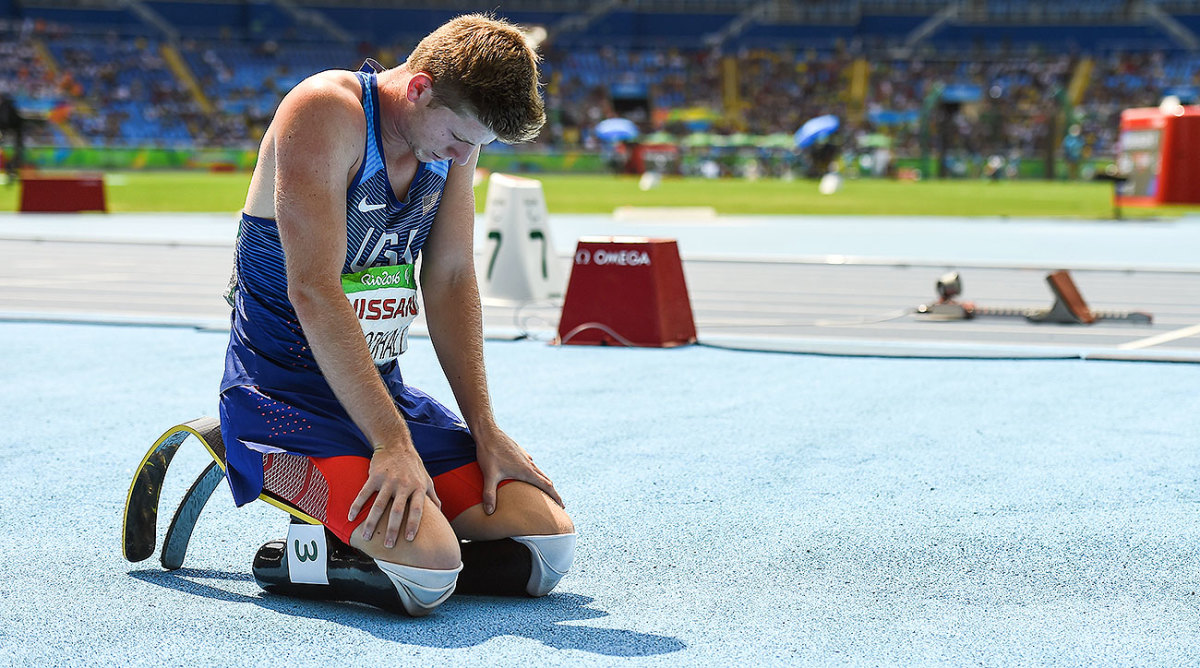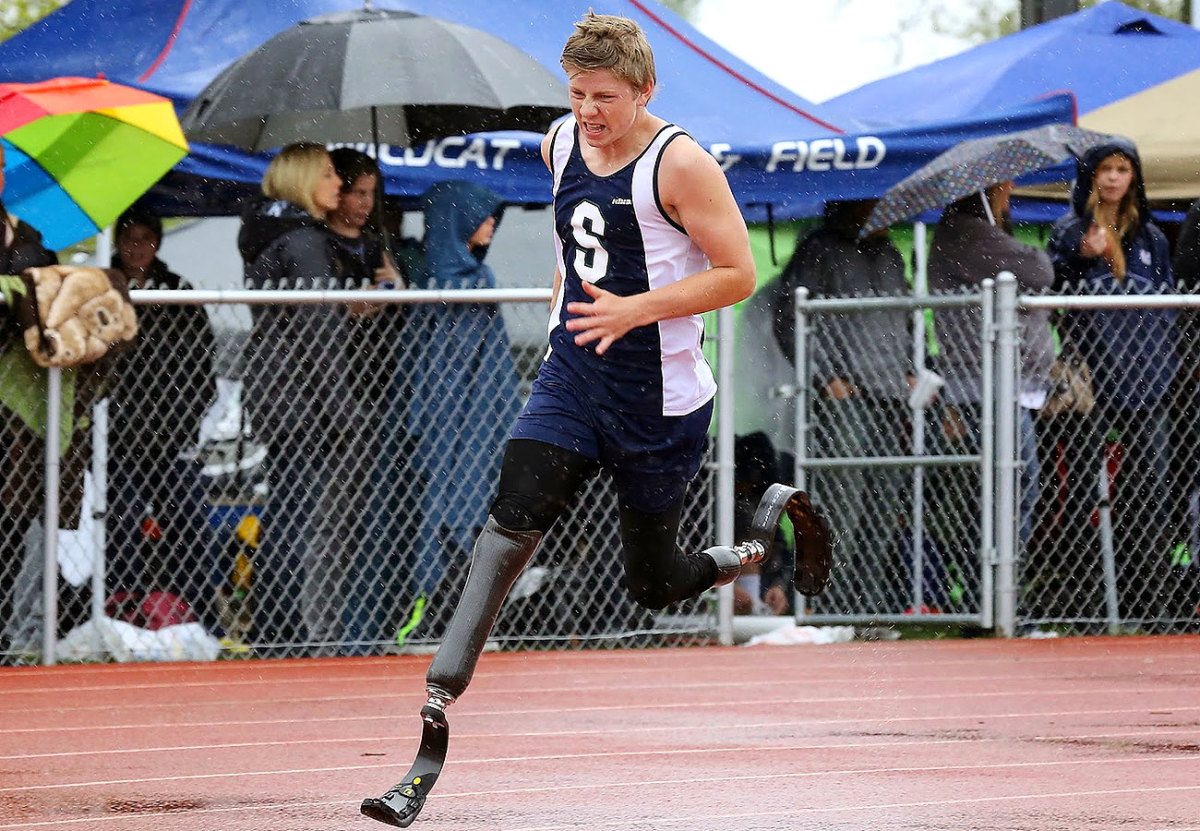After losing his legs shortly after birth, Hunter Woodhall found his place on the track

As Hunter Woodhall crossed the finish line, disappointment set in. The eighth grader was dead last in the semifinals of his local junior high championships, and he knows he won’t get to compete in the finals. His 2012 season is over. But the crowd, clapping and cheering in the stands, doesn’t seem to share his sentiments.
“Why would they clap for the loser?” he wondered.
Then he looked down, and the answer hit him. “They’re cheering because I don’t have legs.”
That realization changed his life.

Woodhall was born with fibular hemimelia, a condition affecting about 1 in 10,000 infants that stops lower limbs from developing properly. When he was 11 months old his legs were amputated, and now Woodhall runs with a pair of prosthetics that look like upside down question marks attached at his knees.
“In that moment I realized these people are just content because I am out here doing my best,” he said. “But that wasn’t good enough for me. I wasn’t going to be seen as just someone with a disability, I was going to be seen as an athlete. I knew that the only way I was going to change that perception was to become the best athlete possible, to become the most competitive athlete.”
Little did Woodhall and his family know that in the near future, the athlete from Syracuse, Utah would break high-school state records, win medals at the Paralympics and sign a DI track-and-field scholarship with Arkansas.
But 18 years earlier two terrified parents sat in a doctor’s office, hearing that their infant son would need his legs amputated. Barb and Steve Woodhall certainly weren’t thinking about colleges or athletic scholarships at that time. Instead they were about to make a huge, permanent decision for their son, who—at just three days old—could provide zero input.
“At that time we didn’t really know what it would be like,” Barb Woodhall said. “We had nothing to compare it to, so we had no way of knowing what he could do.”
They had been told that amputation was the best chance for Hunter to lead a normal life. Otherwise he would likely spend most of his childhood in a hospital, undergoing numerous surgeries that would never fully fix his legs.
After his daughter's tragic death, Tyson Gay is on the road to recovery, running in her memory
Their quest for normalcy didn’t go quite as expected, because Woodhall’s life is far from normal. Normal high schoolers don’t set records, and they certainly don’t compete in the Olympics. Woodhall has done both.
But the beginning of his success story is about as normal as they come. As a young boy, Woodhall was looking for a place to fit in. Homeschooled until fifth grade, Woodhall says he entered public school right when kids started noticing differences in each other, and because of that, he endured plenty of bullying, which shook his confidence. Without a strong group of friends, he spent most of his time hanging out with his parents and two older brothers. The family has always been passionate about sports, so naturally Woodhall followed their lead, trying as many as he could.
His mother noticed Woodhall’s athleticism from the start. She also noticed his determination, something she believes is the reason for his continued success.
“We knew early on that if he wanted to do something he would figure out how,” she said. “God gave him an extra dose of tenacity.”
With each new athletic endeavor came a trip to Shriners Hospital for Children to have a pair of legs fitted for that activity.
By the time Woodhall was in middle school, his doctor, Stephen Santora and his prosthetist, Eric Green, grew accustomed to sitting down with the young athlete and brainstorming ideas for prosthetics. Each sport required a different set, and each set went through an experimentation process in order to figure out what materials and design were best suited to the athlete and the sport. When Hunter tried football, he started with a pair of "stubbies" — short prosthetics the height of his existing limbs. They had to be soft so as not to cause injuries to other kids during games. Eventually the football legs evolved and his final pair had cleats on the bottom. Woodhall loved being active, but he didn't love football, wrestling, soccer, baseball or anything else he tried—until he found running.
Each year the Woodhalls competed in a 5K fun run, and Hunter, who had already crossed a variety of sports off his list, decided he would give running a go. He had a pair of special prosthetics built at Shriner, and almost instantly he found what he was looking for.
“Right after that I started running with my family and I just had a sense of belonging,” he said. “I loved it from the beginning.”
After that first 5K, Woodall stopped looking for his place and started focusing on running.
He joined his middle school track team and Woodhall’s football feet were permanently replaced with sprinting feet. The feet, similar to the ones he wears today, and the sport, both stuck.

Now, each time the running blades propel Woodhall across a finish line he's met with cheers, but also with criticism. The blades, some say, give him an unfair advantage. At this point, though, he's used to the haters trying to explain what they see as unexplainable.
"I think it is one of those things that when someone does something amazing the first thing people do is try to figure out why," he said. "I think it is a reflection of their self-confidence, and I think a lot of people think, 'well if I can’t do it why can you?' They try to find a flaw in the system."
While searching for a flaw, they miss the hard work. They miss the dedication. They miss a teenager leaving home and giving up normalcy for all-day training sessions, six days a week.
And Woodhall’s hard work has brought him plenty of success. He won two medals at the 2016 Paralympics—silver in the 200 and bronze in the 400—and this year he broke high-school state records in those same events. Currently, Woodhall is representing Team USA in the 2017 World Para Athletics Championships in London, where he’s running the 200 and the 400 meters, and the 4x100 relay.
And to top it off, Woodhall became the first double-amputee to earn a DI track scholarship. To the athlete from Syracuse, Utah, the signature felt like a symbol of everything he went through to get to that moment. His name on the paper was a declaration of his hard work.
There have always been people who doubted Woodhall, but he's not doing it for them.
"I’m not doing this to show people how good I am at track, I am doing this to change the perception of what possible is, to change the perception of what normal is," he said. "Maybe what I’m doing isn’t normal, maybe it isn’t something that usually happens, but I want people to be OK with the idea, because there are going to be more people doing things that have never been done before. People need to start realizing that people are amazing, and people are going to do amazing things. We just have to be ready for it."
